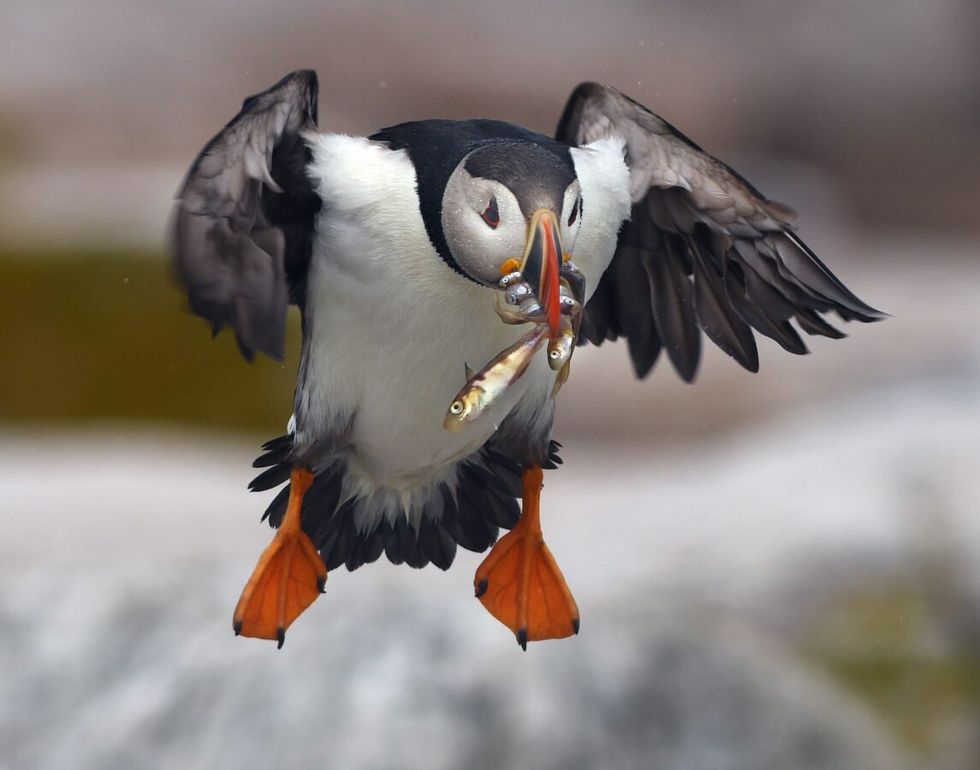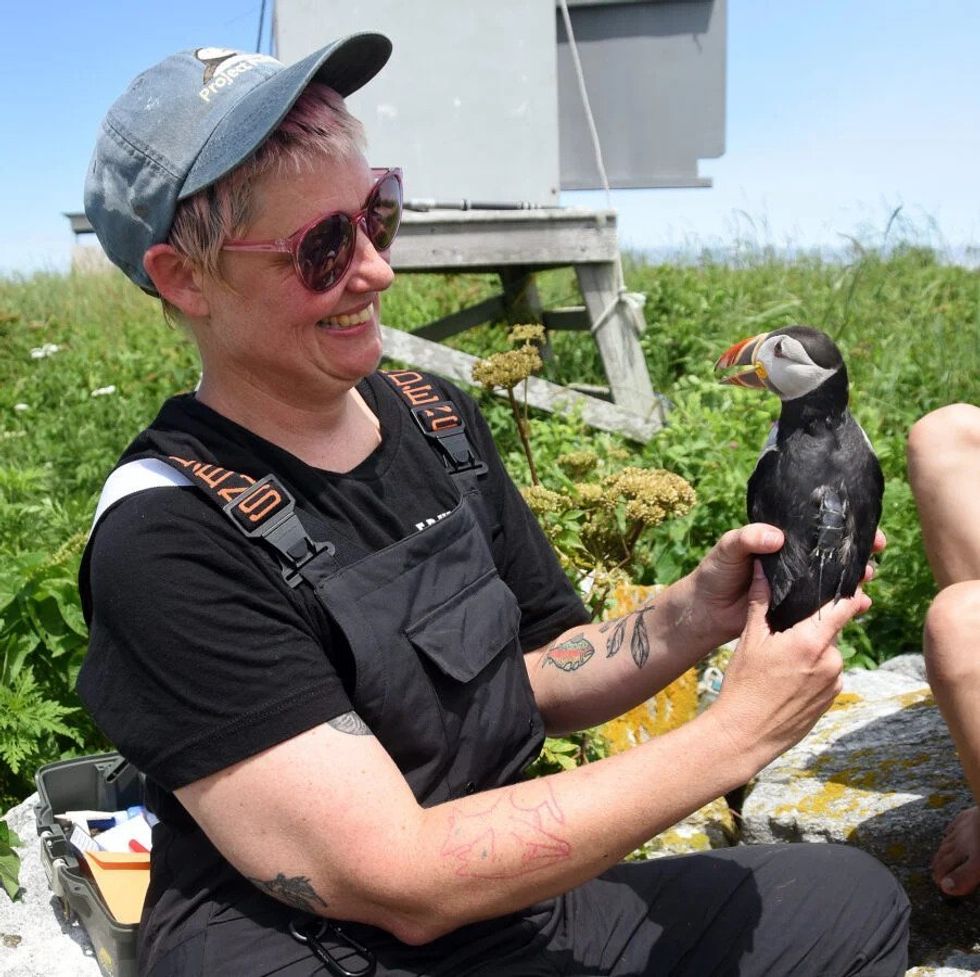
In the Gulf of Maine, scientists race to save seabirds threatened by climate change
“I could see that, if successful, the methods developed could likely help these species."
As co-author of two books on the project, it is humorous how some research methods remain timelessly inelegant.
For instance, there is the practice called “grubbing.” Interns still twist themselves into pretzels to get under boulders to find puffin chicks so they can affix identification bands and weigh and measure the chicks to assess their health.
In my visit this summer to Eastern Egg Rock, the project’s original island six miles out to sea from Maine’s Pemaquid Point, I watched Liv Ridley, 25, slide as flat as a pancake to grub under one set of boulders. Jacob Ligorria, 22, reached upside down in his area, joking about blacking out. Emma Lachance Linklater, 28, looked like a human pinwheel, legs and arms shooting out in four directions. Meg Getzinger, 24, curled herself under a cave to eventually thrust up a puffin chick to me through a crevice.
Climate change bullseye
At dinner, the crew shared with me what they relished about grubbing. They know that the bird’s potential to help humans piece together the mysteries of the ocean has grown exponentially over the decades. “You don’t know how special that bird you grub might become,” Ligorria says. “It could give us data for the next 30 years.”
The data is also exponentially more critical as Project Puffin is in a bullseye of climate change. The project today spreads over seven islands in the Gulf of Maine, one of the fastest warming bodies of ocean on Earth. The last decade has seen unprecedented swings between cooler, calm summers with record numbers of birds, and blazing, stormy summers of catastrophic nesting failure. Water that is too warm drives seabird prey too deep or too far away to catch. Extreme weather events flood nests and soak chicks into hypothermia.
None of this was on the mind of project founder Steve Kress in 1973, when he began bringing down puffin chicks from Newfoundland to raise them on Eastern Egg Rock. Back then, the goal was simply to restore a colorful bird wiped out by hunters on nearly every breeding island in Maine in the late 1800s.
In the early years, Kress and his team fledged nearly 2,000 chicks from Eastern Egg Rock and Seal Island, another island that had gone without puffins for nearly a century. Chicks fledge far out into the Atlantic for two or three years before returning to islands as adults. Kress hoped the grown-up birds would choose Maine over Newfoundland to breed. To make the islands seem like home for puffins and other birds, such as terns, he put up decoys, mirrors and speakers blaring sound recordings of seabirds.
Puffins began breeding anew on Eastern Egg Rock in 1981 and on Seal Island in 1992. Down to a pair of birds in the entire state in 1902, there are now more than 1,300 pairs across several islands in the Gulf of Maine. The project also revived tern species and cousins of puffins, called razorbills and common murre. Chick translocation and tools of social attraction have now been used in more than 850 projects in 36 countries, assisting nearly 140 species of seabirds as far away as Japan, China, and South Africa.
“I could see that, if successful, the methods developed could likely help these species,” said Kress, who retired in 2019. “But I never thought that the methods would be so enthusiastically embraced by so many other researchers so quickly and so very far from Egg Rock.”
Global warming threats

An adult puffin brings back haddock to its chicks.
Credit: Derrick Z. Jackson
In retrospect, those restorations occurred with no time to spare, amid an almost unimaginable 70-percent decline in the global seabird population between 1950 and 2010. That is equivalent to nearly a quarter billion birds, according to a widely publicized 2015 study. The causes: plastic and oil pollution, overfishing, fishing gear entanglements, development, rats and cats brought to islands by humans, and of course climate change.
Thankfully, a new generation of researchers recognizes that, to save seabirds for the next 50 years, they will have to do far more than put out decoys. They’ll have to work toward saving the sea itself.
Gemma Clucas, a 35-year-old post-doctoral fellow at the Cornell Laboratory of Ornithology, conducts DNA analysis on the diet of seabirds, from puffins in Scandinavia to penguins in Antarctica. When I met her this summer, she was out on Matinicus Rock, another island in Project Puffin, 25 miles out into the gulf from the closest coastal town of Rockland, Maine.
Clucas’s research takes the timeless inelegance a serious step further. She often gathers her lab samples by walking through tern and gull colonies with a trash bag over her head. Seabirds have no love for a human traipsing around nests and eggs. They show their displeasure by taking to the skies to poop on intruders. That is exactly what Clucas wants. She scrapes poop from everywhere it plops. The more the better for the lab.
If the birds miss the trash bag, the pants, shirts, hands, faces, even beards of fellow researchers work just as well. She jokes on social media that gathering penguin poo is worse in Antarctica, saying, “I’ll take a tern dive-bomb over an angry, flipper-whacking penguin any day.”
Foraging challenges

Researcher Stef Collar holds a puffin receiving a GPS tag for a foraging study.
Credit: Derrick Z. Jackson
I met Will Kennerley two years ago on Matinicus Rock as he launched a study of puffin foraging habits. The research was for his master’s degree earned this spring at Oregon State University. Kennerly analyzed samples from the summers of 2021 and 2022, which happened to respectively be the warmest and second-warmest years on record for average sea surface temperatures in the Gulf of Maine.
“We’re still pretty in the dark about what puffins actually do for most of their lives.” Kennerley told me. “Protecting these breeding islands is an incredibly important step, but providing a place to raise a chick is of little use to a seabird if they’re not able to find enough food.”
Kennerley’s study, mentored by Clucas, brought several new things to light. Even with the warmest waters on record, puffin adults are quite impressive in finding what fish they can—at least up to a point.
When Project Puffin started, the primary fish for puffins was herring. While herring are rare for puffins today because of overfishing, Kennerley found that adult puffins brought back to their chicks a total of 17 species of sea life and fed themselves 28 species out at sea. Several species detected were previously unknown in the diet of adult puffins, including Atlantic salmon. But warm water can quickly flip variety into scarcity. During marine heat waves, puffins flew farther away from Matinicus Rock to find food and made more dives yet brought back less fish. That resulted in below-average puffin reproduction.
“There are limits to just how hard they can work and successfully raise a chick,” Kennerley said. That limit appeared as a bright line during the record warmth and climate-change-driven rain extremes of 2021 which led to mass nesting failures and chick mortality. As Kennerley wrote: “an invisible threshold of prey scarcity had been crossed, beyond which no added effort could compensate.”
GPS connects ecosystem dots
Back on Eastern Egg Rock, Stef Collar, a researcher who’s worked extensively to monitor and track seabirds all the way to China, was performing another of those timelessly inelegant tasks, waiting patiently for puffins to land on a box on the boulders. When one did, Collar pulled a string that opened a trap door. She texted Lachance Linklater to rush over to help pull the puffin out of the box and put a GPS tag on the bird.
This particular puffin was being tagged for a new set of foraging studies being led on several islands in the Gulf of Maine by Keenan Yakola, a doctoral student at Oregon State, and a 10-year veteran of Project Puffin. Yakola, with the help of each island’s intern teams and accomplished veterans like Collar and Clucas, tagged puffins, terns and Leach’s storm petrels. The latter bird is a favorite of researchers because it is mysteriously nocturnal and unleashes loud trilling calls in the middle of the night from nests that can be right under the tent platforms.
Leach’s storm petrels are also remarkable for leaving breeding islands for three to five days at a time, traveling hundreds of miles to forage for a single chick. An adult might come back to an island for only 15 to 20 minutes to regurgitate food to the chick, then fly off on another 500-to-600-mile feeding journey.
One of the petrels Yakola tagged flew from Maine to waters off Virginia. Another made five trips over three weeks to the Northeast Canyons and Seamounts National Marine Monument. The southern part of that protected ocean lies at the latitudes of Philadelphia, Atlantic City, and the iconic birding area of Cape May, New Jersey.
The monument, a major feeding ground for seabirds and whales, was created by the Obama administration. Its protections against commercial fishing were temporarily gutted by the Trump administration, then restored by the Biden administration. Nearly a decade ago, Project Puffin discovered that some puffins wearing geolocators used the Canyons and Seamounts as a late-winter feeding ground before returning to Maine to breed.
Yakola’s findings help cement the science warning us what lines should never be crossed in ecosystem protection. He and Kennerley both hope their work helps inform the burgeoning offshore wind industry where to site farms with minimal impact to seabird feeding grounds and migratory routes.
“This helps show just how many habitats we actually need to protect,” Yakola said. “With the changing water temperatures, terns and puffins are constantly on the move, so we need to get as fine a scale as we can.”
How fine a scale of understanding these researchers can get to may help tip the scales toward ensuring that Project Puffin lasts another 50 years and that seabirds all over the world have a chance to rebound. “People look out at the ocean and think of it as kind of empty,” Collar said. “Every puffin surprises us with more knowledge of how it is not.”
These views do not necessarily represent those of Environmental Health News, The Daily Climate or publisher, Environmental Health Sciences.
This post originally ran on The Union of Concerned Scientists blog and is republished here with permission.














